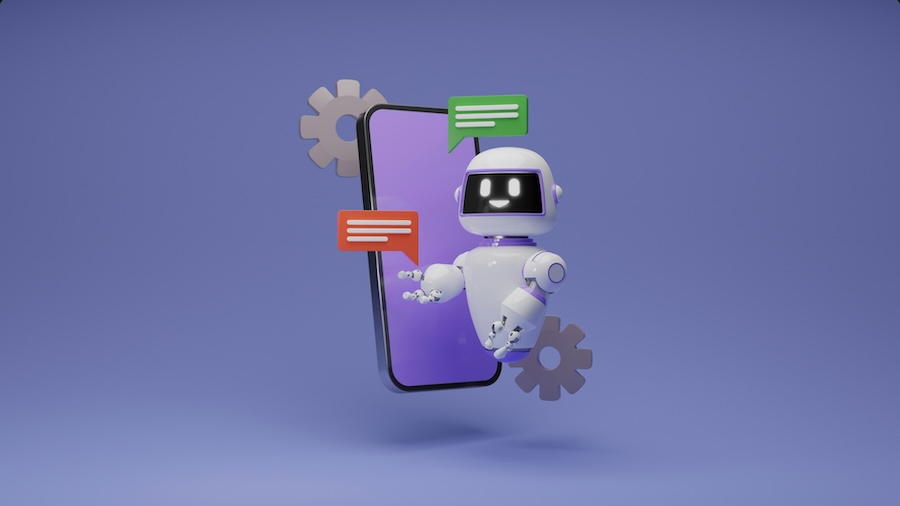Artificial intelligence (AI) is the most disruptive innovation of the modern age. While it covers a huge range of technologies and innovations, AI voice chatbots are among the most beneficial of these for contact centers.
Voice-based chatbots have been around for a long time, predating many of the most publicized chatbot technologies, such as generative AI. While they may not have captured public attention the same way, their longer history means they’ve evolved considerably over the years. Learning to implement a chatbot voice assistant can benefit virtually any business with a call center.
What is an AI voice chatbot?
AI voice chatbots are exactly what their name suggests. They’re an AI program that communicates with human users through spoken language. Voice-based chatbots can take many forms, but all center on natural language processing (NLP). This is the branch of AI that teaches intelligent models to read and analyze human language, not just code. It’s the same underlying technology behind spell checkers and automated closed captioning but in a more sophisticated form.

Source: Unsplash
All chatbots use NLP in two ways — first, they interpret their user’s input, and then they deliver an output in logical, grammatically correct language. A voice-activated chatbot has another layer of complexity because it cannot rely on plain text. Instead, it must recognize and transcribe spoken language, which means accounting for various accents and potential microphone issues.
Given these unique concerns, voice AI models are relatively complex. However, experts have been working with and improving this technology for years, so modern versions are more reliable than some may expect. Studies show people can only distinguish between AI-generated voices and humans about half the time and perceive both as sounding “natural.”
Chatbot vs. voicebot
As with many branches of AI, there are several similar but distinct terms to keep track of when discussing AI voice chatbots. One of the most important distinctions to make is that between a chatbot and a voicebot.
It’s easiest to think of the chatbot and voicebot dynamic as squares and rectangles. All squares are rectangles, but not all rectangles are squares. In the same way, all voicebots are chatbots, but not all chatbots are voicebots.
“Chatbot” refers to any automated service that communicates with users in natural human language. The ever-popular ChatGPT is an excellent example. People can converse with the bot as they would with another human on an instant messaging app. However, ChatGPT is a text-based chatbot — it only communicates in written words.
A voicebot is a specific type of chatbot that uses verbal language. Instead of typing queries, users speak them out loud. Siri is a familiar voice chatbot example for many people, though it can also communicate in text.
Watch the video about the benefits of an AI virtual assistant, Aurora Borea:
Voice assistant vs. chatbot
It’s also important to understand the distinction between voice assistants and chatbots. The differences start with the chatbot vs. voicebot discrepancy in that voice assistants are a type of voicebot. However, voice assistants have additional capabilities that not all voicebots feature.
A voice assistant — sometimes called a “virtual assistant” — does more than hold conversations. These AI chatbots also connect to a broad range of data and services to automate tasks at the user’s request. Consider the Siri example. Apple’s resident voice assistant can make calls, schedule events, adjust settings and control HomeKit devices if consumers ask.
Chatbots and voice assistants overlap in many ways, but the latter is a more sophisticated technology. It may help to think of them as chatbots connected to a larger automation platform. The user interface resembles any other voice AI chatbot experience, but the possible actions cover a far greater range of tasks. Because of this added functionality, voice assistants are often the more beneficial technology for businesses.
How to use voicebots for call centers
Branded voice AI solutions have many possible applications. While smartphone assistants may be the most familiar example for consumers today, call centers can benefit from this technology more than most workplaces. It should come as no surprise that voice AI-based automation is one of the leading call center technology trends today.
One of the more obvious ways to use voicebots for call centers is to create an automated support line. Businesses can use a voice recognition chatbot to talk to customers when no human representatives are available. This is a common approach — interactive voice response handles twice as many calls as human agents.

Source: Unsplash
Of course, there are multiple ways to go about this. Some companies automate their call centers entirely, while others prefer only to use voice chatbots if an employee can’t get to the phone immediately.
Alternatively, call centers can use voicebots to field calls before connecting customers to service reps. The voicebot software can gather basic details to determine which department the user needs to talk to, streamlining the customer service process. Another possibility is to use chatbot voice recognition to collect data on client conversations for employee reviews or sentiment analysis.
Advantages of AI chatbots with voice for call centers
Across all these varying use cases, voicebot platforms have many benefits for contact centers. Here are a few of the most notable.
1. Around-the-clock help
One of the biggest advantages of chatbot voice solutions is that they can work 24/7. The rise of e-commerce means businesses may have customers in multiple locations and time zones other than their own. Implementing AI in customer service lets them care for these clients regardless of time differences.
Even if a company lacks a global audience, it’s impossible to know when a buyer will need support. Only taking calls during normal business hours isn’t ideal because many consumers work during these periods. Consequently, people may feel the brand’s customer support falls short if they don’t have around-the-clock help desks.
Contact centers could hire multiple shifts to provide continuous service, but this requires significant staffing levels. Labor expenses aside, hiring enough people to run a manual 24/7 helpline is challenging. The U.S. has 2 million more job openings than unemployed workers, resulting in a substantial employment gap. An E-commerce voice chatbot is a far more cost-effective and reliable solution. Bots can fill in where there aren’t enough employees and require no salary apart from IT maintenance costs.
2. Higher-quality service
Chatbot voice assistants can also improve the quality of a business’s customer support. The first way they do so is by shortening wait times. While studies find customers are somewhat indifferent about mildly longer waiting times, that stops applying as more time passes. Shorter-than-expected wait times also produce higher satisfaction rates.

Chatbots with voice recognition enable higher-quality support from human agents, too. As these AI models communicate with customers, they can use optical character recognition (OCR) and similar technologies to analyze the user’s needs, background and even mood. Putting these insights into words and passing them along to employees makes it easier for workers to tailor their solutions to individual clients.
3. Multilingual support
Another advantage of AI voicebots is that they can manage requests in multiple languages. Voice recognition in artificial intelligence can detect and translate different dialects in near-real time, overcoming language barriers that would otherwise hinder customer service.
Support for multiple languages is becoming more important as businesses serve an increasingly global audience. However, it’s challenging to meet with human workers alone. While nine out of 10 employers in the U.S. rely on employees with multilingual skills, one in three report a foreign language skills gap. More worryingly, roughly 25% have lost business because of this obstacle.
Learning a language as an employee is hard, but a single machine learning model can support dozens of tongues. ChatGPT can work in over 50 languages, and many other chatbots build upon the same foundational model.

Source: Unsplash
Integrating a multilingual AI voice generator enables call centers to offer the same support to all customers, regardless of their native language. Including less common languages could even attract customers from competitors.
4. In-depth analytics
Chatbot tone of voice analysis and similar features are a less obvious but equally beneficial application of this technology. Artificial intelligence voice recognition tools can monitor help desk conversations to judge customer sentiment and employee performance. These insights can be crucial in customer care analytics workflows.
A person’s tone of voice and word choice reveal a lot about how they feel. Consequently, analyzing these factors is a helpful way to gauge satisfaction without a formal survey. Voice AI solutions can perform such analysis on every phone call customer service workers have.
This AI application could show which employees achieve the highest customer satisfaction or are the most consistently polite. Conversely, it also reveals workers whose tone or word choice can improve for better service. In either case, tracking these trends enables more informative and relevant employee reviews so call centers get more out of their workforce.
5. Opportunities for engagement
Voicebot support provides more opportunities to engage customers. Involving more of a person’s senses makes interactions more impactful — consider how 57% of viewers will donate to nonprofits after watching a video. An artificial intelligence voice generator can drive similar engagement by getting deeper interaction from users.
Typing questions is quick and convenient but unengaging. Businesses that speak to users out loud make a more meaningful connection and engage more senses. As a result, their conversations have a higher chance of leading to conversions or lead generation.
Of course, not every customer will want to have a verbal conversation with a chatbot. However, providing the option ensures companies meet a wider variety of unique needs. That way, they can reach consumers in whichever way they’re most comfortable. Such personalization is key to retaining a loyal customer base in today’s marketplace.
Potential downsides of voicebot solutions for call centers
While AI voice chatbots offer plenty of benefits to contact centers, no technology is perfect. Organizations should also consider a few potential disadvantages to make the most informed decisions.
1. Loss of human connection
The biggest downside to chatbot and voicebot operations is that they’re not a one-to-one replacement for human contact. As capable as these technologies are, they are not people, and that alone is enough to make some customers hesitant about them.

Source: Unsplash
Many users prefer to speak to human agents — one study found that 81% of consumers would wait to talk to another person rather than use a chatbot. It’s worth noting that people are more willing to speak with chatbots past the six-minute mark, and sentiments vary between age groups.
Similarly, chatbots are preferable to humans in cases where customers feel embarrassed about their issues. However, the general leaning toward human connection deserves attention.
Businesses defaulting to chatbots or using them as replacements for customer service agents may accidentally turn buyers away. This trend may change as conversational AI voice solutions become more humanlike, but for now, companies should balance automation and manual workforces.
2. Cybersecurity concerns
Voice artificial intelligence tools may also introduce some cybersecurity and privacy risks. Like all machine learning models, training conversational AI requires considerable amounts of data. Hosting all this information in one place could draw unwanted attention from cybercriminals.
Such concerns aren’t unique to voice AI but still deserve attention. Businesses without a secure data warehouse could lose a lot of information in a single attack. This risk is particularly pressing for smaller companies that may lack the resources for extensive protection.
Call centers should also consider the possibility of more technology-specific threats. Artificial intelligence voice recognition software may store audio files of authorized users’ voices, opening the door to privacy breaches if an attacker steals them. Cybercriminals may also perform data poisoning attacks, where they infect training datasets to limit the bot’s accuracy. Failing to catch such an incident could lead to disastrous customer conversations.
Concerns like these do not mean voicebots are inherently dangerous. Organizations can secure vulnerabilities once they’re aware of them, but the possibility may make some businesses uneasy.
3. Technical errors
Contact centers must always consider the likelihood of technical glitches and machine learning errors. As reliable and advanced as voice AI technology has become, no model is perfect. Depending on how businesses use it, a bot’s mistakes could cause critical missteps in customer service.
Voice chatbot apps have previously offered customers misleading and even entirely incorrect information. In early 2024, a Canadian airline had to pay a customer over $800 in damages after its bot promised a discount he didn’t qualify for. A separate airline chatbot erroneously sent a customer a link to a suicide prevention hotline in 2018.
Mistakes like these stem from a phenomenon known as “AI hallucinations.” Misleading training information or misinterpreting that data — often due to model complexity — are typically to blame, much as they are in human error. However, chatbot mistakes may stand out more, as AI lacks logic, so it can’t catch “facts” that seem off.

Source: Unsplash
Proper training and careful implementation help prevent these mistakes. Still, the risk of an AI voice synthesizer turning a customer away because of a simple error may not feel worth it to some businesses.
AI voice chatbots in contact centers today
While these potential downsides deserve consideration, they have not stopped AI voice chatbots from growing. This technology has become an industry standard among call centers.
A 2022 survey found 76% of contact centers use chatbots to some extent. These companies have noticed impressive results from these solutions, too. Over 85% say the bots manage at least 10% of their calls, significantly reducing the workload on human agents. At some facilities, that figure is as high as 30%.
Nearly half of these centers report that using chatbots to field calls before agents reduces overall customer call times. The same number say they enable a smooth handoff to human help desk employees. Lower costs, less burnout and improved customer satisfaction all made the list of reported benefits.
While these advantages remain consistent across contact centers using voicebots, how companies use them differs. Some replace workers with AI. These workplaces do not usually forgo human employees entirely, but they operate with reduced staff as voice chatbots handle more calls. Other businesses see AI as merely a tool to assist their current workers without impacting staffing levels.
Looking ahead: The future of voice-enabled chatbots
Contact center future trends will undoubtedly shift in response to these existing AI use cases. The most obvious change ahead is that chatbot voice technology will become even more dominant throughout the industry. Some experts predict at least 80% of customer service organizations will use generative AI by 2025. Considering how call centers are almost at that figure already, such a future seems likely.
How businesses use this technology will also shift as it grows and evolves. Chatbots have already proved capable of basic customer interactions, but more sophisticated applications could become more common. For example, more contact centers could perform real-time marketing analytics as voicebots talk to customers for accelerated lead generation and conversion.
As natural language understanding improves, chatbots will be able to handle more cases without human intervention. Such extensive automation would minimize workloads and related burnout while improving customer service speeds and quality of care. Even small businesses with minimal staffing numbers could handle huge call volumes.
How to make a voice chatbot
In light of these trends, contact centers must learn how to do AI voices in their own operations to remain competitive. Here’s what this process looks like.
1. Start with a clear goal
First, organizations must determine a specific application for their voice AI technology. Two of the five major reasons AI projects fail are planning-related issues, such as unrealistic expectations or missing value-based use cases. Consequently, teams must decide on a clear, value-driven goal to inform the rest of the AI initiative.
Does a call center want to reduce customer wait times? A conversational AI solution will likely be needed to field calls before directing them to human agents. Is the quality of service a bigger concern? A speech recognition and sentiment analysis algorithm may be more beneficial.

Source: Unsplash
Whatever goal the business sets should be specific and stem from an existing problem leaders have noticed. Investing in AI for AI’s sake is a surefire way to limit returns on investment (ROIs). By contrast, using voice AI solutions as an answer to a relevant concern will lead to more substantial improvements.
2. Choose an optimal machine learning model
Once companies know what they’ll use voice AI for, they can select a machine learning model that suits the purpose. Organizations can use an off-the-shelf chatbot solution or build their own voice-enabled chatbot in Python or another programming language they’re familiar with. In either case, model selection is crucial to the project’s success.
Large language models (LLMs) are the standard for most NLP applications, but these deep learning networks come in many forms. General-purpose LLMs like GPT-3 and BERT are versatile but can have accuracy issues. Task- or domain-specific LLMs have a narrower focus, which makes them less flexible but more reliable. As such, they’re a good fit for AI in service applications, where customers will have more process-specific questions.
Companies can narrow their choices by looking at the types of models that fit their target use cases. From there, they should consider their budget and technical expertise to ensure they can reasonably program and run the algorithm within their unique constraints.
3. Train the model
All machine learning models, from a Python voice recognition chatbot to a no-code text-to-speech algorithm, need training. This is the stage where data scientists introduce the AI solution to data and correct its output so it learns to work as it should.
Model training requires extensive information. However, quantity is not the only consideration — it must also be relevant to the end use. For example, a speech recognition model should train on audio data covering similar questions to what it’ll answer once deployed. Quality is another concern — training data should contain complete and accurate information to prevent hallucinations and other inaccuracies.
Depending on the type of model in question, training may involve minimal input from data scientists or require continuous monitoring and adjustment. In either case, businesses should continue training the AI solution until it consistently delivers the results they’re after. While it’s tempting to deploy a voice chatbot as quickly as possible, taking the time to ensure higher accuracy will be worth it.
4. Connect the voicebot to appropriate data
The importance of relevant, high-quality data isn’t over after training. Once a voice AI chatbot is ready for use, businesses must connect it to the information required to complete its work.
Call centers using voicebots for sentiment analysis should connect them to their customer relationship management (CRM) solution. That way, they can view call data as a part of larger service and satisfaction trends. Similarly, companies offering customers a general-purpose chatbot voice assistant should give it access to the internal business information needed to provide accurate answers or complete service tasks.

Source: Unsplash
Organizations may need to review their data architecture to get the most out of this step. It will be easier to get a complete picture of the information a bot has access to and what it needs when teams have an up-to-date, informative data map. Improving network transparency will also make it easier to secure the voicebot.
5. Deploy and adjust
After following those four steps, contact centers are ready to implement their voice AI solution. However, the work is still not over. All machine learning applications require ongoing monitoring and adjustment to reach their full potential.
The first few weeks or months of voicebot usage will reveal what the bot excels at and where it can improve. Teams can take these insights and retrain the model, adjust its parameters or otherwise tweak it to refine its performance. These small changes prevent larger errors and ensure a better ROI.
This step is easiest when teams set goals tied to their initial project outline in the first stage. Tracking the same key performance metrics over time will show progress and offer hard data on the voicebot’s performance. Falling short of these targets does not necessarily mean the AI project failed. Rather, they reveal where the model needs adjustment to succeed in these areas later.
Considerations for implementing voice AI solutions
Given voice AI’s potential downsides, companies should look beyond basic implementation steps. Organizations must keep a few extra considerations in mind to overcome common obstacles and use voice-enabled chatbots to their fullest potential.
-
Use AI and human employees together
One of generative AI’s most controversial aspects is its impact on jobs. Consequently, businesses should use voice AI to help employees rather than replace them. A complementary approach will also help companies get more out of their technology and workforce.
AI chatbots and humans have different skills, so organizations should use them differently. They could let workers handle most calls but use speech recognition software to analyze service quality and client satisfaction. Alternatively, they could deploy voice assistants as a first step to manage higher volumes and gather notes for faster, more helpful human interactions afterward.
Businesses may want to glean insight into consumer sentiment on AI interactions to learn where to use it. Working with an experienced customer experience consulting partner is an ideal way to accomplish this.
-
Start narrow and grow from there
Building an AI chatbot with voice functionality can also introduce cost and complexity concerns. The best way to handle these issues is to adopt a gradual investment strategy for this technology.
Contact centers should start with a narrow focus, applying voicebots to a single task. This application should be wherever the business stands to gain the most from AI. After this use case shows a positive ROI, the team can discuss where to expand their chatbot solution. This slower, step-by-step approach to chatbot implementation will produce slower returns, but it makes it easier to overcome challenges and avoid high upfront costs. Consequently, it’s often the most beneficial way to proceed in the long run.
-
Ensure data privacy
Cybersecurity concerns also require attention. Businesses should only collect customer data necessary for the voicebot to work properly. Anything beyond that may introduce more privacy risks than the resulting benefits justify.
Companies must also protect whatever data they collect during training and model deployment. A reliable cloud services partner can help, as it’s easier to defend one database than several. Specific protections include limiting access permissions, encrypting all data, and deploying continuous monitoring technologies. All employees should also receive cybersecurity training. Many incidents occur because of human error, so greater awareness and experience will prevent many breaches.

Source: Unsplash
-
Turn to the experts
Organizations should recognize that they don’t need to go it alone. AI voice chatbots are complicated, and many businesses lack experience with them. Consequently, teaming up with an AI consulting partner is often the best way forward.
AI experts can offer crucial insight into what type of model will benefit the company most. Similarly, they can provide needed advice and help in training, deploying and securing the voicebot so contact centers enjoy the full benefits of this technology without suffering from its risks.
Artificial intelligence voice recognition is the future of call centers
AI voice technology is a game-changer, especially for call centers. As intimidating as such innovations may seem, there’s not much to fear if businesses know what to expect. Learning about voicebots, their benefits, potential pitfalls and best practices is the first step in forming the contact center of the future.



